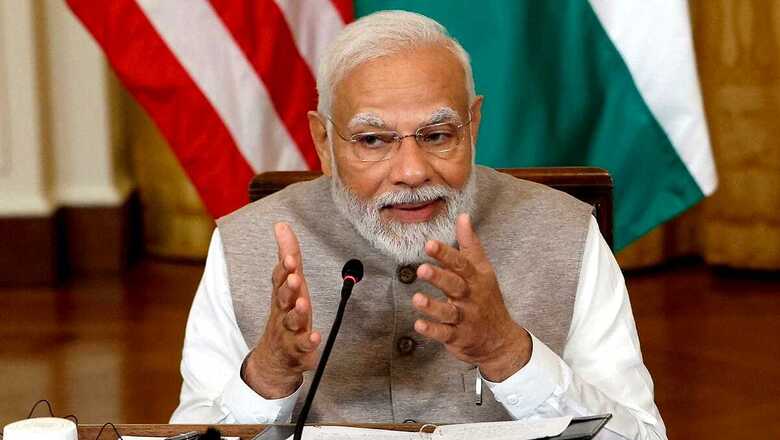
views
Tweeting an article by a top US-based investment firm that expressed firm belief in the India growth story, Prime Minister Narendra Modi on Sunday said it has nine interesting points particularly for “youngsters and entrepreneurs”. “India is a global bright spot with a strong desire to grow even more!” the PM wrote in the tweet, which carried a link to the June 30 article on the website of Capital Group.
The article underlines, “India’s significance as a rising global power came to light with Prime Minister Narendra Modi’s recent visit to the United States, where he addressed Congress, met with high-profile business leaders and dined at the White House.”
Youngsters and entrepreneurs will find these 9 points interesting. And yes, India is a global bright spot with a strong desire to grow even more!https://t.co/PMfO8ze1Jg— Narendra Modi (@narendramodi) July 16, 2023
Before it makes the nine key points, it asks a pointed question in the headline: “Will India be the breakout emerging market this decade?”
It goes on to answer it with an optimistic outlook in the introductory paragraphs, “From our recent travels around the country, we believe indications are pointing in the right direction: Corporate confidence is high, the economy is expanding at a decent clip and technological innovation is leading to new areas of growth.”
The three writers — equity portfolio managers Brad Freer and Shlok Melwani, and investment analyst Rahul Sadiwala — stress that “the country has seen relative political stability over the past 10 years, allowing economic development to be a top priority”.
‘Secular growth ahead’
They foresee a period of “secular growth, fueled by significant expansion in direct and fixed asset investment”.
The first of the article’s nine points is that reforms have set the stage for growth.
“Since Prime Minister Narendra Modi took office in 2014, he and his team have helped usher in pro-business reforms,” it says, especially listing the use of Aadhaar, a national goods and services tax (GST), and Unified Payments Interface (UPI) as examples.
“Modi, while still controversial on some social and human rights issues, has delivered in terms of governance, infrastructure and economic programs,” the three writers claim, and restate the much-underlined mathematical foresight: “India is projected to become the world’s third-largest economy behind the United States and China by 2027, according to the International Monetary Fund.” India is currently the fifth largest, after Japan and Germany.
The second and third points speak of “the infrastructure boom” and a claimed spurt in manufacturing.
“As an example, the town of Palava, 20 miles from Mumbai’s central business district, is a master-planned community that reminds us of what we used to see in China. In 15 years, Palava has gone from a concept to a city of 120,000 residents,” the article states on the infra point.
On manufacturing capacity, it adds, “Modi’s team has been aggressive in courting Japanese, Taiwanese and U.S. companies to invest in new capacity. Apple is producing its iPhone 14 line in India, while Japanese companies Daikin and Mitsubishi Electric are teeing up investments to make air conditioners and related parts.”
Versus China
The writers say they anticipate India will become a desirable location for companies looking to diversify their supply chains outside of China, “a strategy commonly known as China plus one”. “That said, it likely has many years to go before it can challenge China as a global manufacturing powerhouse,” they add.
In the fourth point, it stressed that “India’s equity market has been growing and should evolve”. “The country’s capital markets have seen a proliferation of initial public offerings (IPOs) in recent years. The types of companies going public — and those in the IPO pipeline — reflect its ongoing transformation. These include online platforms such as Paytm (payments), Zomato (food delivery services) and Policybazaar (insurance quote aggregator)… India is now behind only the U.S and China in terms of the number of unicorns (unlisted companies valued at $1 billion) as of December 2022.”
Reliance as example
The fifth point buttresses the India-great-for-investment argument, listing real estate, banking and mobile communications in particular. “Reliance (Jio), in particular, has witnessed rapid growth, underscoring the pace of India’s digital revolution,” the article notes.
Further, in the sixth point, “China plus one” is cited again to claim that the chemicals industry “exemplifies how both governments and multinationals are turning to India to diversify manufacturing beyond China”. “That said, India’s chemicals industry is a fraction of that of China, the world’s largest produce,” it adds.
In their seventh point, the writers hope that the “energy transition” in India could be “transformational”. Here again, China is seen as a benchmark or competitor for India. “Indian corporations are seeking to compete with China all along the value chain of clean energy, especially with green hydrogen. So far, the companies looking to capitalize on this effort include Reliance Industries, Larsen & Toubro and Tata Power,” says the article.
“If (the energy transition is) done right, the payoff could be massive: The country is a large importer of oil and gas, so more renewable power would make it more energy independent. It would also significantly boost its manufacturing base.”
India’s ambition in this area, however, is “in the early stages”.
Young population as asset
In the eighth point, the writers list India’s demographics — a young population eager to work — as “the biggest advantage”. This is a point often made by Prime Minister Modi himself.
“With a median age of 29 years, India in our view has one of the most attractive demographic profiles among the world’s largest economies and can reap benefits from its productive capacity, provided the right policies are in place,” says the article.
The last of the nine key points in the article is that “valuations are stretched but not insurmountable”. Simply put, it means that, “Currently, the market looks a little expensive by historical standards… That said, we believe the fundamental outlook for India is arguably better than ever.”
As for Capital Group, which has carried the article on its site, it lists among its top credentials the fact that it is “investing on behalf of institutions since 1968”.
It claims that “we’ve helped a range of institutional clients pursue their long-term investment objectives”. It is “one of the world’s largest investment management organizations”, managing “$2.2 trillion in assets” at present.



















Comments
0 comment